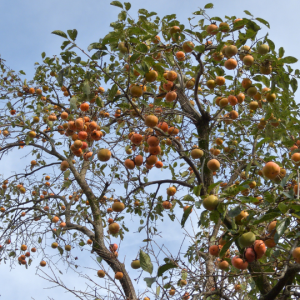
Diospyros kaki
Persimmon
A fast-growing, deciduous fruit tree suitable for rocky areas.
Additional Information
Information | Details |
|---|---|
Botanical Name | Diospyros kaki |
Common Name | Persimmon |
Also Known As | Persimmon |
SA Tree No | |
Tree Type | Deciduous |
Attracts | Birds, Bees, Butterflies |
Features | Rocky Area |
Flowering Season | Spring |
Focal | No |
Fragrant | Yes |
Frost Tolerance | Hardy |
Fruiting Season | Autumn |
Growth Rate | Fast >500mm |
Minimal Leaf Shedding | No |
Origin | Exotic |
Soil pH | |
Root System | Not Aggressive |
Soil Type | Sandy, Loam, Well Drained, Waterlogged |
Suitable Garden Size | Large |
Suitable Planting Area | Full Sun, Semi-Shade |
Fruit, Citrus & Nut Trees Pricing
Bag Size | Price Range Incl. VAT |
|---|---|
4L / 5L
| NA
|
7L / 10L
| R40-R400
|
20L
| R300-R500
|
50L
| R600-R800
|
100L / 200L
| R900-R2000
|
Description
Persimmon is a commonly grown fruit tree that is closely related to date plums. It is ideally used as a hedge plant or ornamental tree and provides bees with tons of nectar and pollen making it excellent for bee gardens.
Persimmon grows well as an indoor or container plant. Its fruit tastes sweet and is filled with plenty of vitamins, minerals, fibre and plant compounds.
- Tolerates temperatures as low as -12°C
- Estimated height: 18m
- Estimated width: 4-7m
- Planting distance: 3-6m
- Low chilling required
Cultivar: Asian persimmon, Diospyros Kaki or Kaki Fruit.
Pollen compatibility: Self-pollinating.
Water requirements: Water regularly.
Fun facts: There are two types of persimmon fruit, astringent and non-astringent. Astringents can only be eaten once they are extremely ripe and soft and non-astringent which can be eaten with their skin whether it’s hard or soft.
















